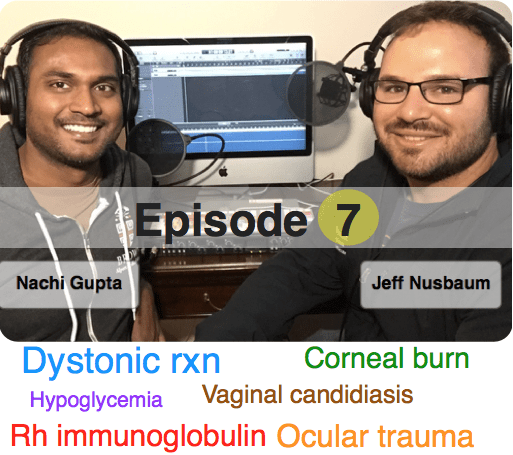Podcast Ep 7: Hypoglycemia, Vaginal Candidiasis, Corneal Burns, & More

I wish to do something great and wonderful, but I must start by doing the little things like they were great and wonderful. -Albert Einstein
Welcome back to another episode of Roshcast. This is Episode 7 and we’ll be talking about Rh immunoglobulin, dystonic reactions, chemical-induced corneal burns, medication-induced hypoglycemia, vaginal candidiasis, ocular trauma, and much more.
The In-Training exam is 92 days away. By consistently studying a little every week and identifying your weaknesses, you can increase your emergency medicine in-training exam score by 10 points.

- Bupivacaine toxicity is treated with intralipid.
- Hydrofluoric acid exposure is treated with calcium gluconate (topically or intra-arterially).
- Benzodiazepine overdoses can be treated with flumazenil. However, be careful in chronic users so as to no precipitate a withdrawal seizure.
- An iron ingestion of greater than 40 mg/kg typically requires chelation. Treatment should be with deferoxamine as charcoal does not bind iron and is therefore of no use.
- Trousseau’s sign is associated with pancreatic cancer. It is a migratory thrombophlebitis.
- Erythema nodosum is a tender, reddish-violet nodule deep under the skin. They can be caused by infections, typically strep, or drugs, with OCPs being the most commonly implicated drugs.
- In a patient with an EBV infection, treatment with either ampicillin or amoxicillin may result in a morbilliform rash.
Some general housekeeping:
You can find our previous episodes here in case you missed them.
Please send us feedback so we can continue to make small improvements to the show.
Remember to leave your comments below to any questions you have on the content and our discussion.
Now to this week’s podcast
Question 1
A 22-year old woman presents with vaginal bleeding. She should be approximately 10 weeks pregnant based on a previous ultrasound, which confirmed an intrauterine pregnancy. On today’s bedside ultrasound, no intrauterine pregnancy is visualized. Her blood type is A negative and the father’s blood type is unknown. Which of the following is true regarding the administration of Rh immunoglobulin?
A. A test dose is administered first because of the risk of an anaphylactoid reaction
B. Rh immunoglobulin 300 micrograms is indicated
C. Rh immunoglobulin is not indicated
D. She can delay Rh immunoglobulin for up to 72 hours
Question 2
A 22-year-old man presents to the ED with clonus of his neck to the right. Which of the following drugs is he most likely taking?
A. Benztropine
B. Cocaine
C. Haloperidol
D. Ziprasidone
Question 3
A patient presents after a chemical splash to the eye. What management is immediately indicated?
A. High volume irrigation
B. Pupil dilation and slit lamp examination
C. Referral to ophthalmology
D. Topical antibiotics and ophthalmology consultation
Question 4
Which of the following medications most commonly leads to recurrent episodes of hypoglycemia?
A. Glargine insulin
B. Glimepiride
C. Metformin
D. Pioglitazone
Question 5
A 34-year-old woman presents complaining of dysuria and vaginal itching. Your speculum exam reveals a vaginal vault filled with a thick, curdy white discharge. Which of the following statements is correct regarding this diagnosis?
A. A fishy odor is present when vaginal discharge is mixed with potassium hydroxide
B. Metronidazole is the recommended treatment
C. Multiple petechiae are often seen on the vaginal wall
D. The pH of the discharge is less than 4.5
E. Vaginal discharge is often foul smelling
Question 6
An 18-year-old softball player is struck in the face with a softball. The CT shows a fracture of the inferior orbital floor. She has numbness over the anteromedial cheek and upper lip. Which of the following nerves is likely to be affected?
A. Anterior superior alveolar nerve
B. Inferior orbital nerve
C. Supratrochlear nerve
D. Zygomatic branch of the facial nerve

- Rh immunoglobulin administration can be delayed up to 72 hours. The correct dose is 50 mcg for those less than 12 weeks gestation and 300 mcg for those 12 weeks and over.
- Haloperidol and other typical antipsychotics can cause a dystonic reaction. The treatment is either benztropine or diphenhydramine. They can both be given IV or IM, with IV being the preferred route.
- A chemical splash to the eye should be immediately treated with high volume irrigation. The eye should be irrigated copiously or to a target pH of 7.0-7.2. Alkali burns typically cause more damage than acidic burns due to their characteristic liquefactive necrosis.
- Sulfonylurea oral anti-hyperglycemics can cause recurrent episodes of hypoglycemia.
- In factitious hypoglycemia, blood work would typically show a low c peptide but high insulin levels due to the exogenous administration of insulin.
- Vaginal candidiasis is characterized by a thick, white, odorless vaginal discharge. It is treated with fluconazole or clotrimazole. The pH of the discharge is typically less than 4.5.
- A fishy-smelling vaginal odor is classic for bacterial vaginosis which is treated with metronidazole. Metronidazole is also the treatment for trichomonas.
- The inferior orbital nerve runs through the inferior orbital floor. It innervates the anteromedial face.





Comments (0)